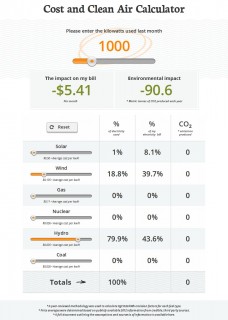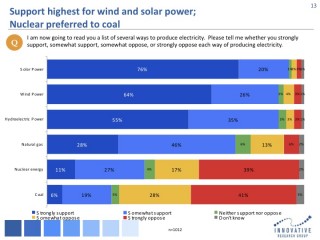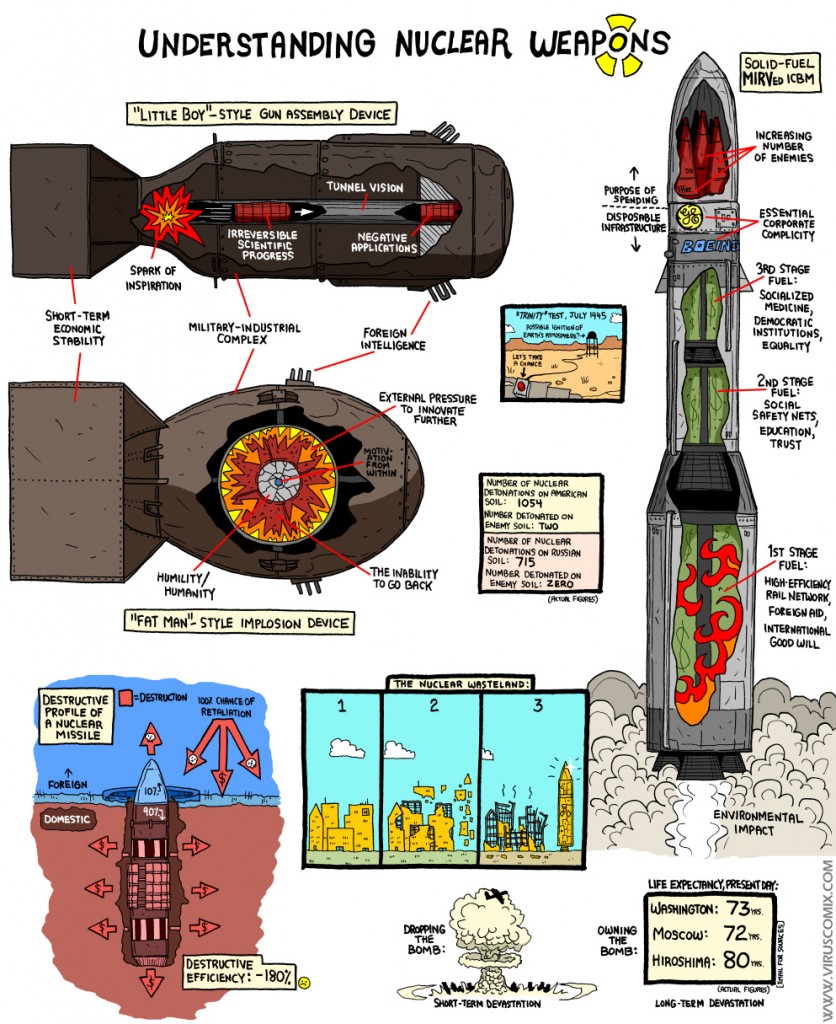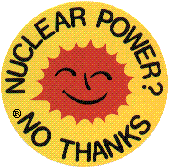
You might have seen the Bruce Power Cost and Clean Air Calculator. It’s supposed to show that nuclear is both cheap and clean, and using anything else would make your bills and your emissions go through the roof. Well, here are 40+ scenarios that all save money and emissions while using no nuclear and no coal:
- 3.9% Solar, 5.7% Wind, 0.2% Gas, 0% Nuclear, 90.2% Hydro and 0% Coal saves $5.09/month and 89.7 t/CO2 annually.
- 2.1% Solar, 10.1% Wind, 0.3% Gas, 0% Nuclear, 87.5% Hydro and 0% Coal saves $8.97/month and 89.2 t/CO2 annually.
- 0.5% Solar, 23.6% Wind, 0.4% Gas, 0% Nuclear, 75.5% Hydro and 0% Coal saves $2.75/month and 88.7 t/CO2 annually.
- 2.1% Solar, 2.5% Wind, 0.8% Gas, 0% Nuclear, 94.6% Hydro and 0% Coal saves $16.32/month and 87.1 t/CO2 annually.
- 3.1% Solar, 0.2% Wind, 1.4% Gas, 0% Nuclear, 95.3% Hydro and 0% Coal saves $13.27/month and 84.5 t/CO2 annually.
- 0.6% Solar, 5.4% Wind, 1.8% Gas, 0% Nuclear, 92.2% Hydro and 0% Coal saves $19.52/month and 82.7 t/CO2 annually.
- 1.9% Solar, 15.8% Wind, 2.5% Gas, 0% Nuclear, 79.8% Hydro and 0% Coal saves $2.48/month and 79.8 t/CO2 annually.
- 0.3% Solar, 13.6% Wind, 2.5% Gas, 0% Nuclear, 83.6% Hydro and 0% Coal saves $12.08/month and 79.7 t/CO2 annually.
- 3.0% Solar, 11.7% Wind, 2.9% Gas, 0% Nuclear, 82.4% Hydro and 0% Coal saves $1.21/month and 78.0 t/CO2 annually.
- 0.1% Solar, 24.8% Wind, 3.1% Gas, 0% Nuclear, 72.0% Hydro and 0% Coal saves $1.35/month and 77.3 t/CO2 annually.
- 2.7% Solar, 4.8% Wind, 3.6% Gas, 0% Nuclear, 88.9% Hydro and 0% Coal saves $8.77/month and 75.2 t/CO2 annually.
- 4.1% Solar, 1.2% Wind, 3.9% Gas, 0% Nuclear, 90.8% Hydro and 0% Coal saves $5.96/month and 73.6 t/CO2 annually.
- 1.3% Solar, 0.3% Wind, 5.6% Gas, 0% Nuclear, 92.8% Hydro and 0% Coal saves $18.44/month and 66.3 t/CO2 annually.
- 2.4% Solar, 0.1% Wind, 6.0% Gas, 0% Nuclear, 91.5% Hydro and 0% Coal saves $13.26/month and 64.7 t/CO2 annually.
- 3.8% Solar, 4.6% Wind, 6.5% Gas, 0% Nuclear, 85.1% Hydro and 0% Coal saves $1.99/month and 62.2 t/CO2 annually.
- 1.4% Solar, 11.8% Wind, 6.8% Gas, 0% Nuclear, 80% Hydro and 0% Coal saves $5.54/month and 61.0 t/CO2 annually.
- 2.9% Solar, 5.7% Wind, 7.0% Gas, 0% Nuclear, 84.4% Hydro and 0% Coal saves $4.64/month and 60.1 t/CO2 annually.
- 0.6% Solar, 14.4% Wind, 7.6% Gas, 0% Nuclear, 77.4% Hydro and 0% Coal saves $6.09/month and 57.7 t/CO2 annually.
- 0.7% Solar, 12.1% Wind, 7.9% Gas, 0% Nuclear, 79.3% Hydro and 0% Coal saves $7.64/month and 56.4 t/CO2 annually.
- 2.1% Solar, 2.9% Wind, 8.5% Gas, 0% Nuclear, 86.5% Hydro and 0% Coal saves $104/month and 53.5 t/CO2 annually.
- 1.9% Solar, 13.5% Wind, 8.6% Gas, 0% Nuclear, 76.0% Hydro and 0% Coal saves $0.36/month and 53.1 t/CO2 annually.
- 2.5% Solar, 3.5% Wind, 8.6% Gas, 0% Nuclear, 85.4% Hydro and 0% Coal saves $7.63/month and 53.1 t/CO2 annually.
- 0% Solar, 5.4% Wind, 8.7% Gas, 0% Nuclear, 85.9% Hydro and 0% Coal saves $17.02/month and 52.9 t/CO2 annually.
- 0.5% Solar, 0.4% Wind, 8.8% Gas, 0% Nuclear, 90.3% Hydro and 0% Coal saves $19.53/month and 52.4 t/CO2 annually.
- 1.6% Solar, 3.9% Wind, 9.7% Gas, 0% Nuclear, 84.8% Hydro and 0% Coal saves $10.31/month and 48.5 t/CO2 annually.
- 2.6% Solar, 6.6% Wind, 9.9% Gas, 0% Nuclear, 80.9% Hydro and 0% Coal saves $2.76/month and 47.6 t/CO2 annually.
- 0.6% Solar, 9.6% Wind, 10.5% Gas, 0% Nuclear, 79.3% Hydro and 0% Coal saves $8.70/month and 45.2 t/CO2 annually.
- 1.4% Solar, 1.0% Wind, 10.5% Gas, 0% Nuclear, 87.1% Hydro and 0% Coal saves $13.58/month and 44.9 t/CO2 annually.
- 0.9% Solar, 12.1% Wind, 11.7% Gas, 0% Nuclear, 75.3% Hydro and 0% Coal saves $3.96/month and 39.9 t/CO2 annually.
- 0.4% Solar, 13.9% Wind, 12.6% Gas, 0% Nuclear, 73.1% Hydro and 0% Coal saves $3.89/month and 35.7 t/CO2 annually.
- 0.3% Solar, 10.7% Wind, 13.3% Gas, 0% Nuclear, 75.7% Hydro and 0% Coal saves $6.89/month and 32.9 t/CO2 annually.
- 0.3% Solar, 10.5% Wind, 13.3% Gas, 0% Nuclear, 75.9% Hydro and 0% Coal saves $7.11/month and 32.8 t/CO2 annually.
- 0.2% Solar, 17.8% Wind, 13.6% Gas, 0% Nuclear, 68.4% Hydro and 0% Coal saves $0.18/month and 31.8 t/CO2 annually.
- 2.3% Solar, 6.9% Wind, 14.0% Gas, 0% Nuclear, 76.8% Hydro and 0% Coal saves $0.96/month and 29.8 t/CO2 annually.
- 3.5% Solar, 0.2% Wind, 14.0% Gas, 0% Nuclear, 82.3% Hydro and 0% Coal saves $2.11/month and 29.7 t/CO2 annually.
- 0.6% Solar, 15.2% Wind, 14.0% Gas, 0% Nuclear, 70.2% Hydro and 0% Coal saves $0.68/month and 29.6 t/CO2 annually.
- 3.1% Solar, 3.4% Wind, 14.9% Gas, 0% Nuclear, 78.6% Hydro and 0% Coal saves $09/month and 26.0 t/CO2 annually.
- 2.2% Solar, 3.6% Wind, 16.8% Gas, 0% Nuclear, 77.4% Hydro and 0% Coal saves $2.65/month and 17.8 t/CO2 annually.
- 1.4% Solar, 1.3% Wind, 17.1% Gas, 0% Nuclear, 80.2% Hydro and 0% Coal saves $8.29/month and 16.2 t/CO2 annually.
- 1.1% Solar, 4.5% Wind, 18.2% Gas, 0% Nuclear, 76.2% Hydro and 0% Coal saves $5.74/month and 11.5 t/CO2 annually.
- 0.1% Solar, 13.3% Wind, 19.1% Gas, 0% Nuclear, 67.5% Hydro and 0% Coal saves $0.70/month and 7.9 t/CO2 annually.
- 0.1% Solar, 6.4% Wind, 19.8% Gas, 0% Nuclear, 73.7% Hydro and 0% Coal saves $7.47/month and 4.7 t/CO2 annually.
- 0.7% Solar, 8.7% Wind, 20.6% Gas, 0% Nuclear, 70% Hydro and 0% Coal saves $1.73/month and 1.2 t/CO2 annually.
Sure, some of these won’t be practical from a dispatch/capacity perspective, but hey, that’s Bruce’s issue to explain away.
I couldn’t have done it without this tiny routine to produce a list of random numbers that all add up to 1. No way was I clicking those sliders 10000+ times. Viewing the source was handy, though.
sub rndnormsum {
# generate N uniformly distributed random numbers that sum to 1
# see http://stackoverflow.com/a/2640079/377125
my $n = shift; # number of entries to return
my @arr = ( 0, 1 );
foreach ( 1 .. ( $n - 1 ) ) {
push @arr, rand;
}
@arr = sort(@arr);
my @result = ();
foreach ( 1 .. $n ) {
push @result, $arr[$_] - $arr[ $_ - 1 ];
}
return @result;
}



